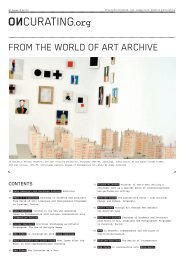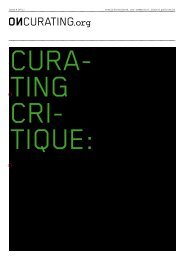Create successful ePaper yourself
Turn your PDF publications into a flip-book with our unique Google optimized e-Paper software.
015 Issue # 11/11 : PublIc Issues<br />
Public <strong>as</strong> strategy<br />
In mid 2003, leading Mumbai newspapers carried articles stating that the government had<br />
allotted a piece of land in Bandra (a suburb of Mumbai) to certain developers. The news-<br />
papers also mentioned that the developers intended to develop commercial and residential<br />
real-estate on the site (fig. 7). This land w<strong>as</strong> marked <strong>as</strong> a recreational ground in the<br />
Development Plan (the M<strong>as</strong>ter Plan) of the city and belonged to the Housing Authority. Due<br />
to its location, this piece of land w<strong>as</strong> prime property and w<strong>as</strong> valued at Rs. 200 Crores<br />
in the year 2003. Disturbed by the news, the Residents' Association of the neighboring<br />
apartments decided to approach the Bombay High Court with a plea for maintaining the use<br />
of this land <strong>as</strong> a recreational ground. The members of the Association were inspired by<br />
the c<strong>as</strong>e of Oval Maidan (another recreational ground in South Mumbai). The Oval Residents'<br />
Association had fought a court c<strong>as</strong>e, where they argued that the Maidan (large open space)<br />
w<strong>as</strong> under severe threat of abuse and misuse <strong>as</strong> the Municipal Corporation w<strong>as</strong> unable to<br />
maintain it. They also insisted that the responsibility of maintaining it should be handed<br />
over to the Oval Residents' Association. The Mumbai High Court had instructed the Resident's<br />
Association to prove their capacity in a pilot period of one year to organise<br />
resources and improve the Maidan. Subsequently the Residents' Association, with the help<br />
of several private groups, upgraded the open space. They made several small interventions:<br />
the area w<strong>as</strong> fenced, the open space w<strong>as</strong> levelled for efficient drainage, are<strong>as</strong> for<br />
different purposes were demarcated and several private agencies were appointed to use and<br />
maintain the area. Following the success of the first year, the court <strong>as</strong>ked the Municipal<br />
Corporation to hand over the maintenance of the Maidan to the Oval Residents' Association.<br />
The Residents' Association from Bandra approached an urban research group to help them<br />
with their intentions. They <strong>as</strong>ked the research group to prepare a two-part document – the<br />
first part containing arguments for the court c<strong>as</strong>e towards keeping the space open and not<br />
allowing the government to hand it over to a private developer; the second part comprised<br />
designs for the improvement of the open space and (organizational and financial) plans<br />
for its maintainance. This document w<strong>as</strong> not only prepared for the court, but it w<strong>as</strong> also<br />
for the private parties who were to invest in the development of the area <strong>as</strong> well <strong>as</strong><br />
for the various state and private institutions whose blessings were required for the deve-<br />
lopment of the space. The Residents' Association wanted to prepare itself to take over<br />
the open space like the c<strong>as</strong>e of Oval Maidan.<br />
The research group strategized the first part containing arguments for the court c<strong>as</strong>e<br />
around the ide<strong>as</strong> of public space. It made a detailed report, empirically proving the<br />
shortage of public open space in the area and the need to keep this place open for public<br />
use. So far this w<strong>as</strong> simple. However things became complicated in the second part. The<br />
research group started the project with a detailed survey of the space and the community<br />
that w<strong>as</strong> going to use it. They found that a part of the space w<strong>as</strong> being occupied by a<br />
small informal settlement. Also, the open space w<strong>as</strong> used by the dwellers of this settlement<br />
<strong>as</strong> well <strong>as</strong> other informal settlements in the neighborhood. There were also other<br />
users of the open space like occ<strong>as</strong>ional hawkers who sold their wares around the open space.<br />
Part of the open space w<strong>as</strong> rented for exhibitions and other community activities like<br />
marriages. On the other hand, interviews with the members of the Residents' Association<br />
of the apartments indicated that they wanted to enjoy the benefits of open space for<br />
environmental re<strong>as</strong>ons (ecological balance, ventilation, and breathing space) and also for<br />
cultural ones (recreational purposes, social and cultural gatherings). They were specifically<br />
concerned about the elderly and the children. A number of them did not have a<br />
problem with the land being developed into congruent activities like a Gymn<strong>as</strong>ium, Sports<br />
Centre, Exhibition hall, Community Hall, Library, Swimming Pool, Theatre, etc. The entire<br />
group, however, w<strong>as</strong> unanimous about its dislikes: it did not like the slum-dwellers and<br />
hawkers using the open space and felt that parcelling the land for other activities<br />
like exhibition and marriages w<strong>as</strong> a public nuisance. The Residents' Association insisted<br />
that the space be developed <strong>as</strong> a public space and that non-congruent activities (like<br />
informal settlements, hawking, community activities, etc.) should not be allowed. They<br />
wanted the research group to develop the project with all these demands.<br />
The research group found itself in a dilemma – while it w<strong>as</strong> the research group itself that<br />
had produced the idea of the public <strong>as</strong> a strategy to save the open space from predatory<br />
developers, the idea of the public w<strong>as</strong> highjacked and reproduced by the Residents' Associa-<br />
tion to evict the informal settlers from the open space. The idea of the public w<strong>as</strong><br />
produced <strong>as</strong> a strategy, but it w<strong>as</strong> double edged: while it w<strong>as</strong> useful against appropriation,<br />
it w<strong>as</strong> also problematic when used <strong>as</strong> an intolerant and indiscriminate instrument (fig. 8).<br />
While we have identified a few ways in which the idea of the public is produced, there may<br />
be many more ways in which this production must be taking place. We have not aimed to list<br />
all the ways in which the public is produced – there cannot be such an exhaustive list. In-<br />
stead, we have first sought to explore the idea of the public <strong>as</strong> being the result of a pro-<br />
cess of production; and secondly, we have operationalised this idea by tracing some of the<br />
conceptual trajectories in which the production of the public takes place in urban Mumbai.


![Download as PDF [10.6 MB]](https://img.yumpu.com/4266533/15/500x640/download-as-pdf-106-mb.jpg)

